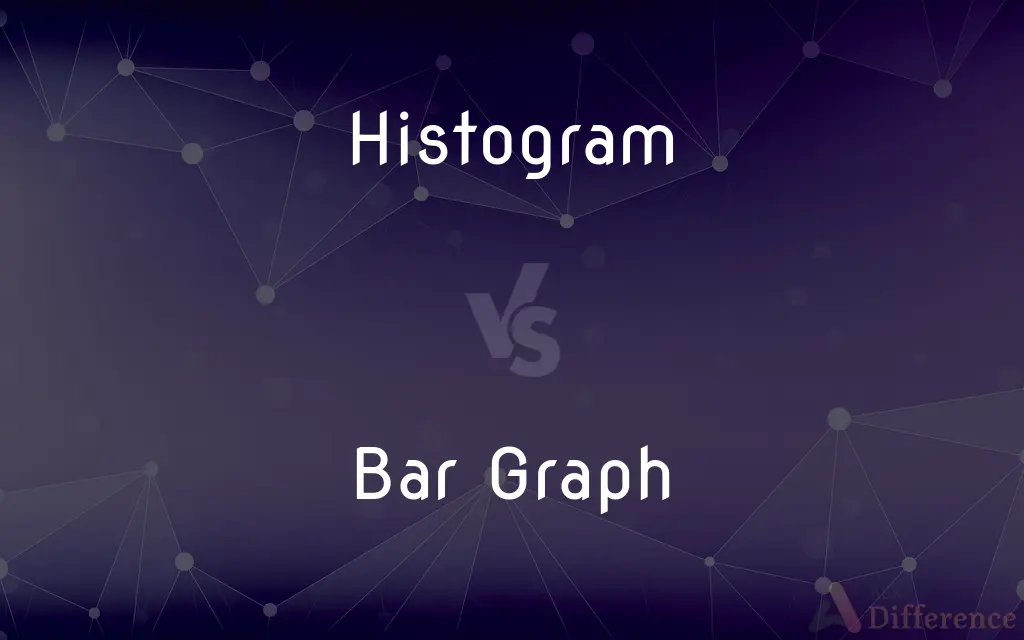Histogram vs. Bar Graph — What's the Difference?
By Tayyaba Rehman — Published on October 8, 2023
A histogram displays frequency distributions of continuous data intervals, while a bar graph compares categories using spaced bars.

Difference Between Histogram and Bar Graph
Table of Contents
ADVERTISEMENT
Key Differences
Histograms and bar graphs are both tools for visualizing data, but they serve different purposes and present data differently. A histogram illustrates the frequency of continuous data points within certain intervals, making it particularly useful for understanding the distribution of values in a dataset. This makes a histogram great for showcasing data like age groups, income brackets, or test scores.
In contrast, a bar graph utilizes individual, separate bars to represent different categories. Each bar corresponds to a specific category, and its height or length represents the value of that category. Bar graphs are ideal for comparing discrete data points or categories, like the sales figures of different products or the number of students in various classes.
It's essential to note the space distinction between histograms and bar graphs. In a histogram, the bars touch each other because it represents a continuous data set, showing ranges of data. In bar graphs, there are spaces between bars, emphasizing the distinct nature of the categories they represent.
To choose between a histogram and a bar graph, one should consider the type of data they have. If the data points are continuous and the goal is to understand its distribution, a histogram is the better choice. However, if one is dealing with distinct categories and wants to compare them, a bar graph is more suitable.
Comparison Chart
Data Type
Continuous
Categorical
ADVERTISEMENT
Bars
Touch each other
Spaced apart
Represents
Frequency distribution of data ranges
Individual data points for discrete categories
Suitable for
Age ranges, test scores
Sales of different products, survey responses
Interpretation
Understand distribution of continuous data
Compare values of different categories
Compare with Definitions
Histogram
A graph using adjacent bars to represent grouped data.
The histogram illustrated the distribution of monthly rainfall in inches.
Bar Graph
A chart showing different categories using bars of varying lengths.
The bar graph depicted the number of books read by students in each grade.
Histogram
A graphical representation of frequency distribution.
The histogram showed most students scored between 70 and 80 on the test.
Bar Graph
A diagram using separate bars to display individual data values.
Voter preferences by party were clearly displayed in the bar graph.
Histogram
A chart displaying continuous data in intervals.
Using a histogram, we visualized the age distribution of our survey respondents.
Bar Graph
A graphical representation of categories using bars.
We used a bar graph to showcase the favorite fruits among students.
Histogram
A visualization tool for understanding data distributions.
The height of each bar in the histogram indicates the number of data points within that range.
Bar Graph
A visualization tool for comparing discrete data points.
The bar graph allowed us to easily compare annual profits of different departments.
Histogram
A diagram showing the underlying frequency distribution of a set of continuous data.
The histogram of sales data revealed a peak during the holiday season.
Bar Graph
A chart representing data with spaced bars.
The bar graph highlighted the monthly sales of each product.
Histogram
A bar graph of a frequency distribution in which one axis lists each unique value (or range of continuous values) in a set of data, and the area of each bar represents the frequency (or relative frequency) of that value (or range of continuous values).
Histogram
(statistics) A graphical display of numerical data in the form of upright bars, with the area of each bar representing frequency.
Histogram
(transitive) To represent (data) as a histogram.
Histogram
A bar chart representing a frequency distribution; heights of the bars represent observed frequencies
Common Curiosities
How does a bar graph differ from a histogram?
A bar graph represents discrete data points with spaced bars, while a histogram displays frequency distributions of continuous data with touching bars.
What is a histogram?
A histogram is a graphical representation showing the frequency distribution of continuous data intervals.
Why do bars in a histogram touch each other?
The bars in a histogram touch because they represent continuous data intervals.
Can a bar graph have horizontal bars?
Yes, a bar graph can have horizontal or vertical bars to represent data.
Can I use a histogram for categorical data?
No, histograms are typically used for continuous data to showcase its distribution.
Why are there spaces between bars in a bar graph?
The spaces emphasize the distinct and separate nature of the categories represented.
Which graph type is best for comparing different categories?
A bar graph is ideal for comparing different categories or discrete data points.
Can I use a histogram to see the distribution of ages in a population?
Yes, a histogram would be ideal for visualizing age distribution as it deals with continuous data.
What does the height of a bar in a histogram represent?
The height of a bar in a histogram represents the frequency or count of data points within that interval.
Share Your Discovery

Previous Comparison
Absorption Costing vs. Marginal Costing
Next Comparison
Rules vs. RegulationsAuthor Spotlight
Written by
Tayyaba RehmanTayyaba Rehman is a distinguished writer, currently serving as a primary contributor to askdifference.com. As a researcher in semantics and etymology, Tayyaba's passion for the complexity of languages and their distinctions has found a perfect home on the platform. Tayyaba delves into the intricacies of language, distinguishing between commonly confused words and phrases, thereby providing clarity for readers worldwide.












































